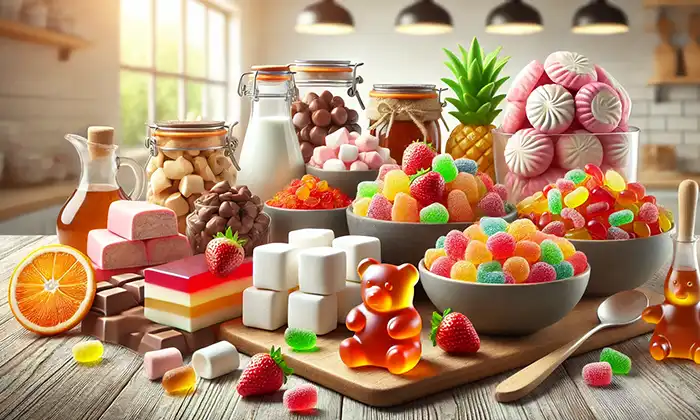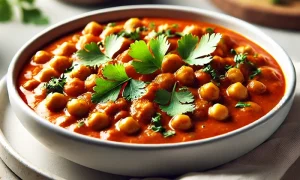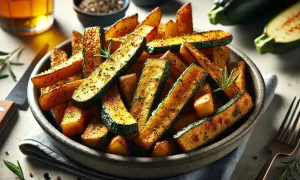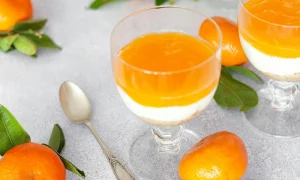Vegan Alternatives for Gelatin

Gelatin, a traditional ingredient in both sweet and savory dishes, is renowned for its unique setting and shaping properties. However, its animal-derived origins make it unsuitable for vegan and plant-based diets. If you’re searching for plant-based substitutes that don’t compromise on texture or flavor, you’re in luck. There are several vegan alternatives that can seamlessly replace gelatin in your favorite recipes.
Common Vegan Gelatin Substitutes (more info below)
- Agar Agar
- Pectin
- Carrageenan
- Cornstarch
- Xanthan Gum
- Guar Gum
What is Gelatin Typically Made of?
Gelatin is a clear, flavorless protein derived from animal collagen. This collagen is primarily extracted from cows and pigs, specifically from nonmuscular parts like skin, bones, and tendons. Through a process of boiling these parts, collagen is rendered into gelatin, which solidifies and thickens liquids upon cooling.
This substance provides structure to various foods, creating textures in products like gummies, marshmallows, and quick pastry creams. Although gelatin’s effects are widely appreciated in the culinary world, it’s not vegan-friendly due to its animal-based origins.
Common Uses of Gelatin
In desserts, gelatin’s thickening and gelling properties are integral. Panna cotta, marshmallows, and gummy candies rely on gelatin for their distinct textures. In dairy products, it stabilizes yogurt and ice cream, helping them maintain their creamy consistency.
Confectioneries frequently use gelatin to create chewy textures in candies like gummy bears and marshmallows. This substance serves a crucial function in pastry creams and custards, where it ensures smoothness and firmness. When preparing savory dishes, you might see gelatin used to create aspic or to stabilize salad dressings.
In industrial food production, gelatin acts as a fining agent in beverages, offering clarity by removing impurities. Certain processed foods use gelatin to enhance texture or as a fat replacer, such as in low-fat products. These common applications highlight its importance but also underscores the challenge of finding suitable vegan alternatives that replicate these properties.
There are Vegan Gelatin Alternatives for Your Recipes
Incorporating vegan gelatin alternatives into your recipes enables you to enjoy textures similar to those provided by traditional gelatin without using animal products. These plant-based substitutes open up new possibilities for culinary creativity.
Why Choose Vegan Alternatives?
Opting for vegan alternatives to gelatin supports ethical and dietary preferences, as traditional gelatin is derived from animal collagen. By using plant-based options, you can still make all of your favorite recipes without utilizing animal-based products and keeping things fully plant-based. These alternatives often offer unique flavors and textures, enhancing both sweet and savory dishes without compromising on quality.
Key Ingredients in Vegan Alternatives
Explore key ingredients in vegan gelatin alternatives to successfully adapt your recipes:
- Agar Agar: This popular substitute comes from Japanese red algae and sets firmer than gelatin. Agar agar is ideal for making jellies and custards due to its flavorless profile and reliable gelling properties.
- Apple Pectin: Commonly used in jams and jellies, apple pectin provides excellent gelling abilities and enhances fruity flavors. It offers a reliable gelatin-like texture for crafting spreads and fillings.
Choosing these ingredients not only aligns with dietary choices but also expands your range of recipe possibilities.
Popular Plant-Based Substitutes
With more people choosing plant-based lifestyles, the demand for vegan alternatives to gelatin has increased. Below are some top choices that offer excellent gelling properties for your culinary needs.
Agar Agar
Agar agar is a common vegan substitute for gelatin, made from Japanese red algae. Available in powdered or flaked form, it creates a firmer set ideal for jellies and mousses. Dissolve it by grinding and cooking until it liquefies completely. For every 2 cups of liquid, use 2 teaspoons of agar powder or 2 tablespoons of flakes. Note that agar agar sets at room temperature and offers a reliable, firm texture comparable to traditional gelatin.
Pectin
Pectin, primarily found in fruits like apples and citrus, serves as a thickening agent. It’s an excellent option for jams and jellies, enhancing fruity flavors. Pectin requires a sugar-acid combination to gel properly, making it perfect for sweet applications. Use it to preserve the natural taste and texture of your recipes.
Carrageenan
Carrageenan, derived from seaweed, closely mimics gelatin’s properties. Available in iota and kappa forms, it suits different textures. Use iota carrageenan for soft desserts like puddings, and kappa for firmer creations such as vegan cheese. One ounce of carrageenan usually gels 1 cup of liquid, offering a versatile and vegan-friendly substitute for many recipes.
Cornstarch
Cornstarch thickens liquids, providing a smooth texture. Ideal for puddings, sauces, and gravies, it activates when heated, creating a glossy finish. Mix 1 tablespoon of cornstarch with water, then heat to thicken 1 cup of liquid. Although it doesn’t set like gelatin, it adds substantial texture to recipes.
Xanthan Gum
Xanthan gum is a powerful thickener made from fermented sugars. Frequently used in gluten-free and vegan recipes, it stabilizes and thickens sauces, dressings, and baked goods. Use sparingly, as 1/4 teaspoon can effectively manage 1-2 cups of liquid. Its ability to maintain consistency over time makes it a staple in plant-based cooking.
Guar Gum
Guar gum, derived from guar beans, acts as a binding agent. It’s excellent for improving texture in ice creams, sauces, and gluten-free baking. Use at a ratio of 1 teaspoon per 1 cup of liquid to achieve desired consistency. Guar gum helps maintain moisture in recipes, making it a valuable gelatin substitute.
Tips for Using Vegan Gelatin Substitutes
Using vegan gelatin substitutes requires understanding their unique properties to achieve the desired texture in recipes.
- Agar Agar Preparation: Ensure agar agar dissolves fully in liquid by boiling it before use. This step is crucial, as it doesn’t dissolve in cold liquids.
- Pectin Usage: When making jams or jellies with pectin, add the right amount of sugar and acid to activate it for proper gelling.
- Carrageenan Application: Use carrageenan for creamy textures in dairy-free products like puddings and plant-based milks. It’s heat-stable and dissolves easily.
- Cornstarch Thickening: When substituting with cornstarch, create a slurry with cold water to prevent clumping, then add it slowly to the hot liquid.
- Xanthan and Guar Gum: Measure these gums accurately, as small amounts suffice for thickening and stabilization. They work best for sauces and dressings.
- Adjust Recipe Ratios: Since vegan substitutes don’t have the same properties as gelatin, altering the quantity may be necessary to match the expected outcome.
Taking these specific steps with vegan substitutes enables you to recreate the textures and consistencies gelatin normally provides, expanding plant-based cooking possibilities.






